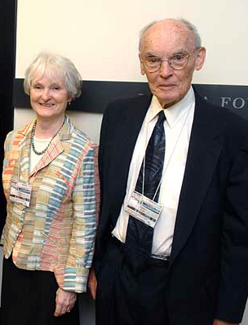Donor Profile: Jim and Sylvia Earl
Jim ’53, PhD ’57 has had a lifelong passion for physics and he and his wife Sylvia have been great friends and supporters of the MIT Physics Department. They have named their gifts in honor of people that were important to them.
by Erin McGrath // MIT Physics Annual 2017

The Helena Foundation Junior Laboratory
After Jim graduated from Omaha Central High School in 1949, he entered MIT expecting to study electrical engineering. However, two events in his freshman year convinced him to study physics instead. The first occurred during freshman physics laboratory, which was supervised by a graduate student named Robert Noyce—who later co-founded Intel Corporation—and who introduced Jim to the concept of experimentation. The second event was the arrival from Europe of Stanislaw Olbert—who became an MIT physics faculty member—and who lived in Jim’s fraternity house and became a trusted mentor.
As Bruno Rossi’s student, Olbert introduced Jim to the cosmic ray research group, which included William Kraushaar; he supervised Jim’s bachelor’s thesis on the properties of a large ionization chamber. Jim’s graduate work continued under Kraushaar at the Agassiz Air Shower Experiment at the Harvard College Observatory, where he studied the muonic component of extensive air showers.
While at MIT, Jim met Sylvia, a native of Newton, MA, and a student at Wheelock College, where she said it was her good fortune to have met Jim. After they married, the Earls lived at the Westgate barracks for two years. Between two babies, she performed in a play as the moon goddess Selene, which took place in the Little Theatre of MIT’s Kresge Auditorium. Sylvia recalls being perched on top of a stepladder for the duration of the play.
After MIT, Jim spent a year as a Second Lieutenant with the Army Signal Corps Laboratory at Fort Monmouth, New Jersey, working on the Vanguard 2 weather satellite. However, before it was launched Jim left for an academic position at the University of Minnesota. There, Jim began a series of experiments using cloud chambers to study cosmic rays at the top of the atmosphere. (Earlier, Edward Ney had pioneered this approach to space research.) It led to a very notable result: Jim’s discovery of primary cosmic ray electrons.
After a few years, Jim left Minnesota for the University of Maryland, where he began experiments using balloons to carry Geiger tube hodoscopes to visualize and identify particles at the top of the atmosphere. Results of this research were an early determination of the spectrum of cosmic electrons at very high energies and the discovery of the J = AT law, which describes the spectrum of solar modulated protons.
Later in his career, after a sabbatical at the California Institute of Technology, Jim turned to theoretical studies of energetic particle propagation in random magnetic fields. These resulted in a simple explanation of the J = AT law and the identification of a coherent mode of propagation that explained observations of “scatter-free” solar particle events.
To confirm theoretical results on propagation, Jim carried out extensive Monte Carlo simulations of particle propagation on the Massively Parallel Processor at Goddard Space Flight Center. This computer was quite primitive, but it could track the behavior of enormous numbers of particles. Consequently, statistical errors were minor and comparison with theoretical results provided convincing verification.
Jim has had a lifelong passion for physics, and he and Sylvia have been great friends and supporters to the MIT Physics Department. They have supported The Helena Foundation Junior Laboratory, and a number of fellowships including the Clark (1952) Fellowship Fund, Boldt (1953 Fellowship Fund), and the Bruno Rossi Fellowship Fund.
The Earls have named their gifts in honor of people that were important to them. As a graduate student, Jim worked on the air shower experiment with George Clark, who was then a recent PhD graduate. Jim notes: “I learned a tremendous amount from him. Later, George dramatically upgraded the junior laboratory. The Clark fellowship is our attempt to recognize him for these personal and institutional contributions.” Jim continues: “Elihu Boldt and I were members of the MIT class of 1953 and as graduate students members of Rossi’s group. When Sylvia and I came to Maryland, we continued our friendship with Elihu and his family. By this time, Elihu had begun his brilliant career at Goddard Space Flight Center. He was an outstanding scientist worthy of recognition by the Boldt fellowship.” And, Jim says, “As you can see from above, Bruno Rossi had a profound impact on my life. For this reason and more general ones, it is certainly appropriate for graduate fellowships to be named after him.”
Outside of physics, Jim has a strong interest in art. At Maryland, he earned two additional undergraduate degrees in studio art and computer science. After retiring in 1999, Jim renewed his interest in art by creating intaglio prints in the print shop at Anne Arundel Community College. Jim notes: “My art has appeared in many shows around Annapolis; a highlight was a one-person show at St. John’s College library, and a few of my etchings have won awards. I also do watercolors and pen and ink drawings in sketchbooks, one of which I always carry in my pocket.”
Sylvia shares, “Jim and I are the parents of four sons and nine grandchildren. Over the years, sixty-two in all, I’ve enjoyed attending MIT reunions, which gave us the opportunity to rekindle old friendships. During Jim’s career, we have attended conferences all over the world and taken sabbaticals in this country and abroad. A memorable one was at Kiel University in West Germany, during which we and our two youngest sons became quite fluent in German.”
Now in retirement, Jim and Sylvia are both busy with the Helena Foundation supporting MIT and other organizations, as well as their special interests in physics, the arts and the environment.